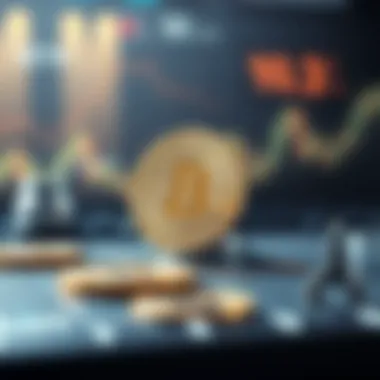Understanding Margin Transactions in Cryptocurrency


Intro
In recent years, the cryptocurrency market has exploded, captivating both seasoned investors and curious novices. Among the myriad of trading strategies available, margin transactions stand out due to their potential for significant profit and risk. Essentially, margin trading allows investors to borrow funds to amplify their trading positions, offering the allure of higher returns. But, as is often the case in the financial world, with great potential comes equally substantial risk.
This article seeks to peel back the layers surrounding margin transactions in cryptocurrency, providing both a foundation for understanding and practical insights into making informed decisions. By the end, readers will grasp not only the mechanics of margin trading but also the nuanced strategies and regulatory landscapes that govern this captivating domain.
Crypto Fundamentals
Before diving deep into margin transactions, it’s crucial to understand the foundational aspects of cryptocurrency that make these transactions possible.
Understanding Blockchain Technology
The heart of the cryptocurrency ecosystem is blockchain technology. At its core, a blockchain is a decentralized digital ledger that records transactions across multiple computers, ensuring the integrity and security of the data without the need for a central authority. This decentralized nature is pivotal for margin trading, as it allows for transparency and trustworthiness—essential factors when leveraging investments. Each block in a blockchain contains a list of transactions, timestamped and linked to the previous block, creating a chain that is virtually tamper-proof.
"Blockchain is the backbone of cryptocurrencies, providing the framework for secure and transparent transactions."
Cryptocurrency Types and Their Uses
Cryptocurrency isn’t a one-size-fits-all solution; instead, it comprises a diverse array of types, each with its own unique features and applications. Some of the most recognized cryptocurrencies include:
- Bitcoin (BTC): The first and most well-known cryptocurrency, often viewed as digital gold.
- Ethereum (ETH): Known for its smart contract functionality, allowing developers to build decentralized applications.
- Ripple (XRP): Primarily designed for cross-border payments and remittances, focusing on facilitating faster transactions.
- Litecoin (LTC): Created as the "silver" to Bitcoin's "gold," it offers faster transaction processing times.
Understanding the differences between these cryptocurrencies is essential for any trader considering margin transactions since each currency behaves differently in the market.
Investment Strategies
Once a solid grasp on cryptocurrencies is established, the next logical step is to explore various investment strategies, including margin trading.
Long-term vs. Short-term Investing
Investing in cryptocurrencies can be approached in two primary ways—long-term or short-term.
- Long-term Investing: This strategy involves buying cryptocurrencies and holding them over an extended period, banking on their potential to appreciate in value. This approach usually requires patience and a strong belief in the underlying technology's longevity.
- Short-term Investing: Often associated with day trading or swing trading, this strategy focuses on capitalizing on smaller price movements. Margin trading can be particularly appealing here, as it allows traders to magnify their exposure to brief market fluctuations.
Risk Management in Crypto Investments
It's important to acknowledge that with high potential returns come high risks. Margin trading exacerbates these risks, so robust risk management strategies are imperative. Consider the following:
- Set Stop-Loss Orders: Automatically selling a position at a predetermined price to limit potential losses.
- Diversification: Spreading investments across different cryptocurrencies to minimize risk exposure.
- Educate Yourself: Keeping abreast of market trends, news, and regulatory shifts that could impact asset value.
Defining Margin Transactions
Understanding margin transactions is crucial for anyone stepping into the realm of cryptocurrency trading. They imbue traders with the potential to amplify their positions using borrowed funds, but they come tethered with an array of risks and complexities. At its core, margin trading allows an investor to buy or sell assets on credit, effectively increasing trading power without necessitating equivalent amounts of capital upfront. This can be seen as a double-edged sword; while it has the allure of magnified gains, it equally heightens the stakes involved in trading.
Margin transactions can often be the key factor distinguishing a novice trader from a seasoned one. An adept understanding can lead to successful trading strategies, while ignorance of the intricacies can result in significant losses. Thus, defining margin transactions isn’t merely a matter of nomenclature but underpins a broader comprehension of financial leverage and the mechanics of trading environments. Here are some elements to consider:
- Leverage: The backbone of margin trading, enabling substantial positions to be taken with relatively small amounts of capital.
- Margin Requirements: Initial and maintenance margins dictate how much must be deposited and kept in an account.
- Risks vs. Rewards: It's not just about potential profits; the implications of leveraging in a volatile market can lead to rapid losses.
This section serves as the bedrock for further discussions about margin trading's mechanics and implications in the cryptocurrency sphere.
What Is Margin Trading?
Margin trading refers to the practice of borrowing funds from a broker to trade financial assets, in this case, cryptocurrencies. Essentially, traders deposit a fraction of the transaction value—known as the margin—while the broker lends the rest. This allows traders to open larger positions than their current capital might otherwise permit.
For instance, let’s say you have $1,000 in your trading account. If you engage in margin trading with a leverage ratio of 5:1, you could theoretically control up to $5,000 worth of cryptocurrency. This creates a proactive environment, as the potential for profit is multiplied, but it also heightens the risk because losses are similarly magnified.
Some common characteristics of margin trading include:
- Increased buying power: Opens opportunities for larger trades.
- Flexibility: Allows for various trading strategies, from long positions to short selling.
- Market Exposure: Engages traders more deeply in market movements and trends.
However, it's pivotal that potential traders recognize that margin trading isn't suited for everyone. It requires a solid understanding of the market and the psychological stamina to manage risks effectively.
Historical Context of Margin Trading
The practice of margin trading is not exclusive to cryptocurrency; it has historical roots in various financial markets. Originating in the stock market, margin trading became popular in the early 20th century, allowing investors to leverage funds to multiply their investment potential. This was particularly prominent during the famous stock market boom of the 1920s, which was partially fueled by investors borrowing heavily to amplify their positions.
Over time, various regulations related to margin requirements emerged, particularly after significant market crashes which exposed the fragility of leveraged investments. The historical context illustrates how margin trading has evolved—but it's pertinent to understand that many of these principles are seamlessly integrated into the realm of cryptocurrency.
Much like the traditional stock market, the crypto landscape offers a volatile environment. As new wallets and exchanges emerge, the concept of margin trading has adapted. For example, the introduction of decentralized finance (DeFi) has revolutionized access to margin trading, allowing users to borrow against their crypto holdings without needing a centralized broker.


Ultimately, the historical evolution of margin trading serves as a reminder of the inadequacies in understanding and managing risk, presenting both opportunities and challenges in today's crypto markets. Traders must take lessons from the past while forging ahead in this dynamic arena.
The Mechanism of Margin Transactions
Understanding the mechanism of margin transactions is crucial for anyone venturing into the domain of cryptocurrency trading. This segment of margin trading illuminates the inner workings of how traders utilize borrowed funds to amplify their market positioning. Grasping this concept can pave the way for making informed decisions, assessing risks, and fully harnessing the potential of margin trading. Key elements such as leverage, initial margins, and maintenance margins form the backbone of these operations, each requiring a nuanced appreciation to navigate the complexities they've secured.
How Margin Trading Works
At its core, margin trading involves borrowing capital from a broker to trade larger amounts than an individual’s available funds permit. In practical terms, if a trader wishes to purchase cryptocurrencies worth $10,000 but only has $1,000, margin trading allows them to borrow the remaining $9,000, boosting their buying power. This mechanism creates opportunities for both significant profits and substantial losses, making it imperative to utilize it judiciously.
A standard approach often entails opening a margin account with a brokerage that supports cryptocurrency transactions. Once set up, the trader can place a deposit, known as the initial margin, to secure their borrowing. This deposit serves as collateral for the loans taken out to amplify their trade. The level of allowable leverage—often ranging from 2:1 to as much as 100:1—varies between platforms and requires careful consideration, as it directly impacts risk exposure.
Key Terminologies in Margin Trading
Leverage
Leverage is one of the most discussed aspects of margin trading, representing the ratio of an investor's capital to the total amount of margin they control. For instance, a 10:1 leverage allows a trader to control a $10,000 position with just $1,000 of their own funds. This capability highlights the key characteristic of leverage—it magnifies both potential gains and risks.
Using leverage can be enticing for its ability to create an illusion of greater wealth and can lead to significant gain in favorable market conditions. However, it’s important to note that it also exposes traders to the risk of magnified losses. The unique feature of leverage is that while your investment can perhaps double in a bullish market, a contrary movement can equally halve your position, prompting the importance of risk management strategies.
Initial Margin
The initial margin is the upfront capital required to open a margin account and start trading. It signifies the minimum percentage of the total investment that traders must fund themselves. As a critical form of security for brokers, the initial margin ensures a buffer against potential losses. The key characteristic of the initial margin is its role in determining how much leverage a trader can utilize.
For instance, if a platform offers a 20% initial margin, this means for every $1 that a trader puts down, they can borrow $4, giving them a total control of $5. The unique feature of the initial margin is its necessity to maintain liquidity in trading; however, it also means that investment strategies must be planned around this fixed capital.
Maintenance Margin
The maintenance margin represents the minimum account balance a trader must maintain to keep their margin account active and to avoid a margin call from the broker. This balance must be maintained after buying on margin, ensuring that the collateral remains adequate to cover ongoing trades. A key characteristic of the maintenance margin is that it acts as a wake-up call for traders; falling below this threshold could trigger the need to sell assets or add additional funds.
The unique aspect of a maintenance margin is its function as a safety net for brokers because fluctuating asset values can lead to under-collateralization. The downside, though, is the pressure it exerts on transactions, occasionally forcing traders to liquidate positions during volatile market swings, which can result in losses from otherwise recoverable investments.
Understanding these elements is vital for navigating the risks and rewards associated with margin trading.
The Benefits of Margin Trading
Margin trading offers a unique avenue for traders to enhance their potential for gain while simultaneously bringing a mix of complexity into their strategy. Unlike conventional trading methods where one can only utilize existing funds, margin trading opens the door to leverage, allowing traders to control larger positions even with limited capital. This article will explore key aspects of margin trading, particularly focusing on how it can amplify potential returns and the variety of trading strategies it facilitates.
Amplifying Potential Gains
One of the most appealing aspects of margin trading is the opportunity to amplify gains. Leverage lets traders borrow funds, increasing their buying power. Imagine you have $1,000 and use it to trade with 5x leverage. It’s like putting your funds on steroids—suddenly you’re controlling a position worth $5,000. If the market moves in your favor, the returns can be significantly higher than those achievable with your own cash alone.
However, it’s not always sunshine and rainbows. Just as gains can be magnified, so can losses. A small downturn can wipe out your entire investment quickly if you’re not careful. Therefore, it’s crucial to manage risk judiciously. Understanding how leverage works—both its benefits and its risks—can mean the difference between riding a wave of profit and taking a plunge into the deep end of loss.
Diverse Trading Strategies
Margin trading doesn't just cater to those looking to increase their positions. It also allows for a variety of trading strategies that can adapt and thrive in changing market conditions. It’s not just about going long; the flexibility of margin trading means that seasoned traders can employ techniques like short selling or arbitrage to profit in nearly any situation.
Short Selling
The crux of short selling lies in betting against an asset. You borrow an asset (like cryptocurrency) and sell it with the hope of buying it back at a lower price later. It’s akin to selling a sweater at a yard sale, expecting to buy it back cheaper in the winter. This tactic is powerful in a declining market, allowing savvy traders to capitalize on downward trends.
What stands out about short selling is its capacity to provide profit opportunities during bearish phases. However, it's a double-edged sword; potential losses can be infinite, unlike traditional buying, where the maximum loss equals the initial investment. This characteristic makes understanding market dynamics imperative for anyone considering short selling as a viable strategy.
Arbitrage Opportunities
Arbitrage presents another enticing aspect of margin trading. The practice involves capitalizing on price discrepancies across different markets. Let’s say Ethereum is trading for $2,000 on one exchange and $2,050 on another. A trader could purchase Ethereum at the lower price and sell it at the higher price. It’s as if you spot a great deal at a clearance sale and immediately turn around to sell it for a profit to someone unknowing that they are forking over more cash.
This strategy thrives on speed and efficiency, as the window of opportunity may be fleeting. It allows traders to secure gains with a relatively low risk profile, especially if leveraged positions are employed. Yet, the advent of automated trading bots and the instantaneous nature of crypto markets means that opportunities can vanish as quickly as they arise. Understanding transaction fees and ensuring quick execution are crucial to making this strategy work.
"In the world of margin trading, timing is everything; the difference between a profitable trade and a total washout often comes down to seconds."
The Risks Involved in Margin Transactions
Margin transactions can be a double-edged sword, slicing through the potential for gains while also exposing traders to significant risks. Understanding these risks is essential for anyone looking to navigate the complex landscape of cryptocurrency trading. Each risk carries implications that can affect not just the bottom line, but also the overall trading strategy and mindset of the investor. Gaining insights into the risks associated with margin trading helps traders manage their positions more effectively and make informed decisions.
Negative Impact of Leverage
When using margin trading, leverage acts as a powerful tool that amplifies both potential profits and potential losses. For instance, if a trader utilizes a leverage of 5:1, it means they can control five times the amount of capital they have put down. However, this means that even slight fluctuations in the asset price can lead to proportionally larger losses. If prices go south, a trader can find themselves in a precarious situation, with losses mounting quickly and potentially wiping out their entire investment.
Furthermore, excessive leverage can blindsight traders into believing that every trade will result in profits, leading to a false sense of security. A trader might THINK they’re sitting pretty, only to wake up one day and realize that their position has been eviscerated by adverse market movements. This reality check can be humbling and, in extreme cases, devastating.


Margin Calls Explained
A margin call is often the boogeyman of margin trading. It occurs when the equity in a trader’s account falls below the required maintenance margin. Simply put, if you’re borrowing money on margin and the reality of loss hits hard, your broker will call on you to deposit more funds to cover your positions. Missing a margin call can set off a chain reaction that results in automatic liquidation of your assets.
Understanding the triggers for margin calls is paramount. Traders need to be aware of the thresholds set by their trading platform. Many traders let their guard down, thinking they can ride out short-term volatility, only to wake up to find their positions liquidated. Staying informed and proactive can help mitigate the shock of a margin call, but it’s crucial to know your limits and the inherent risks that margin trading entails.
Market Volatility and Its Effects
Cryptocurrency markets are notoriously volatile. Prices can swing wildly in a matter of hours, making margin trading even riskier. This volatility can create opportunities for profits, but it can also result in rapid losses. If the market moves against a trader’s position, the situation can escalate quickly, leading to a vicious cycle of losses exacerbated by leverage.
Consider this: a trader could invest $1000 with 4x leverage, putting them in a position to trade as if they had $4000. However, suppose the value of the asset drops by 25%. Immediately, this loss translates to a $1000 loss on an initial capital of $1000—meaning the trader now has no equity left in their account.
In such scenarios, emotional responses can cloud judgment. Traders may panic or impulsively make decisions that go against their original strategy. Navigating such tumultuous waters requires not only a clear understanding of market signals but also discipline to adhere to a pre-defined trading plan. Traders should implement stop-loss measures and risk management strategies to buffer against sudden price changes.
"It's not just the trade that matters, but the way we react to the market's chaos that defines our success in margin transactions."
An awareness of the risks tied to margin transactions can propel traders toward success or push them towards the edge of ruin. It’s essential for traders to continuously educate themselves, remain vigilant, and adapt their strategies to safeguard against these dangers while leveraging the opportunities that margin trading presents.
Choosing a Margin Trading Platform
Selecting the right platform for margin trading in cryptocurrency is essential for traders aiming to navigate this complex financial landscape effectively. The choice of platform can drastically influence a trader’s experience, success, and overall comfort level while engaging with margin trades. This section delves into crucial factors, advantages, and considerations that one should keep in mind when optng for a margin trading platform. Understanding these elements helps traders make informed decisions that cater to their specific needs.
Key Features to Consider
User Interface and Experience
The user interface (UI) plays a pivotal role in how smoothly a trader can operate on a margin trading platform. An intuitive UI can mean the difference between executing trades efficiently or getting tangled in a web of confusion, especially during volatile market conditions. A well-designed interface allows users to access necessary tools and information quickly.
For instance, platforms that spotlight real-time charts and stats give traders an upper hand in making swift decisions. Traders can monitor changes and seize opportunities as they arise. However, not all interfaces are created equal.
Some platforms design their UI with complex features that may overwhelm newcomers. Thus, while picking a platform, assess whether its interface aligns with your proficiency and trading style. Novices may prefer platforms with simpler layouts to avoid unnecessary stress, while seasoned traders might look for advanced tools and quick access to data.
Advantages and Disadvantages:
- Advantages:
- Disadvantages:
- User-friendly interfaces promote quicker execution of trades.
- Accessible designs enhance overall trading experience for less experienced traders.
- Some sophisticated platforms could be daunting for newcomers, leading to mistakes in critical trades.
Liquidity and Security Measures
Liquidity is a cornerstone in the trading of cryptocurrencies, especially when engaging in margin transactions. A platform with robust liquidity ensures that orders are executed swiftly at desired prices, crucial in a fast-paced market. Furthermore, high liquidity tends to minimize the spread between bid and ask prices, which means better potential profits for traders.
On the other hand, security measures cannot be overlooked. In an industry fraught with cyber threats, selecting a platform that prioritizes security is essential. Traders should consider platforms that employ top-notch security protocols such as two-factor authentication, encryption, and cold storage for funds.
But it's not just about the anxious mindset of securing funds. If a platform’s liquidity is poor, traders may find it difficult to fetch favorable prices, especially during times of high market volatility.
Advantages and Disadvantages:
- Advantages:
- Disadvantages:
- High liquidity can be a trader’s best friend when executing large orders or making quick trades without slippage.
- A strong security framework reduces the risk of loss due to fraudulent activities.
- More secure platforms might implement restrictions that could hamper trade execution speed.
Comparison of Leading Platforms
As the margin trading arena evolves, various platforms have emerged offering unique features, risks, and rewards. Here we compare some notable ones to offer insight into their characteristics and suitability for different trading goals.
Platform A
Platform A is equipped with comprehensive tools that enhance traders' capabilities. It's known for offering a combination of competitive fees and a vast selection of crypto assets. This facilitation of diverse trading opportunities supports varied strategies for investors.
One key feature is its responsive customer support, which is notably significant during urgent trading situations. However, its complex functionalities might act as a drawback for traders new to margin trading. Therefore it’s often viewed as more appropriate for those who already possess some expertise and confidence in digital currencies.
Platform B
Platform B is well-regarded for its emphasis on user experience, featuring a clean interface that is intuitive. This is especially advantageous for individuals who are just stepping into trading. Additionally, the platform often provides tutorials and resources to aid integration into the trading world.


Yet, its offerings in terms of asset variety might be somewhat limited when compared to more expansive exchanges. This could restrict avid traders from exploring certain cryptocurrencies that may yield lucrative opportunities.
Platform
Platform C takes pride in exceptional security measures that reassure users while trading significant sums. With adjustable leverage and numerous margin options, it caters to both conservative and aggressive traders. This flexibility invites a broader range of strategies.
Nevertheless, its stringent verification protocols may deter users looking for a quick sign-up process. Some traders might perceive this as a hindrance to access, especially during times of market enthusiasm when entering quickly is desirable.
Ultimately, your choice of a margin trading platform should align with your trading goals, experience level, and risk tolerance.
In summary, selecting a margin trading platform requires careful deliberation of various elements such as user interface, security, liquidity, and platform-specific features. By understanding these factors, both new and seasoned traders can foster a positive trading experience.
Regulatory Framework Surrounding Margin Transactions
Navigating the world of margin transactions involves understanding the regulatory landscape that governs them. This framework is not just a bureaucratic hurdle; it plays a crucial role in shaping the safety and functionality of margin trading, especially in the volatile cryptocurrency markets. The importance of having robust regulations can’t be overstated as they help protect investors from fraud, misuse of leverage, and unexpected market fluctuations. Moreover, they help in promoting transparency and trust among trading platforms, which is paramount for fostering a stable environment for traders.
Global Regulatory Perspectives
Regulations vary significantly across the globe, with some countries taking a more lenient approach towards cryptocurrency margin trading while others impose strict rules. For example:
- United States: Here, the Commodity Futures Trading Commission (CFTC) and the Securities and Exchange Commission (SEC) monitor margin trading activities. They have stringent guidelines to ensure that transactions are conducted fairly and transparently. Any platform operating in the U.S. must comply with laws that prohibit fraudulent practices and enforce detailed reporting requirements.
- European Union: The EU has recently pushed for a more harmonized regulatory approach across its member states under the Markets in Crypto-Assets (MiCA) regulation. This proposes a unified framework to manage risks associated with margin trading and aims to protect investors in an ever-evolving market environment.
- Asia: Countries like Japan have developed a controlled approach, requiring exchanges to register and comply with laws specifically aimed at margin trading. Contrarily, some other nations still lack a clear framework, leaving room for potential malpractices.
"Proper regulation is like a safety net; it doesn’t prevent falls but can lessen the impact when they occur."
In essence, understanding the varying global perspectives is vital for traders operating across different jurisdictions, as these affect everything from the leverage available to the mechanisms for recourse in case of disputes.
Compliance Requirements for Traders
For traders looking to engage in margin transactions, awareness of compliance requirements is essential. Here are a few key elements:
- Registration: Many jurisdictions require that platforms offering margin trading be registered with the appropriate regulatory bodies. This ensures that they adhere to local laws and guidelines, which can significantly reduce the risk of fraud.
- Identity Verification: Most regulators enforce strict Know Your Customer (KYC) norms. Traders need to provide personal identification and financial information to avoid illicit activities like money laundering.
- Risk Disclosure: Platforms must provide clear information regarding the risks associated with margin trading. This transparency allows traders to make informed decisions about whether or not to engage in such activities.
- Reporting Requirements: Traders may be obligated to report their activities, including significant trades and losses, to regulatory authorities. This helps maintain market integrity and prevents manipulation.
- Anti-Money Laundering (AML) Policies: Compliance with AML regulations is essential for platforms and traders alike. It necessitates protocols to prevent the use of margin trading for illicit purposes, ensuring a cleaner trading environment.
Market Trends Affecting Margin Trading
The realm of margin trading is constantly shaped by the fluctuations and developments in the broader cryptocurrency market. Understanding these market trends is vital for traders to navigate successfully through the complexities of margin transactions. Analyzing such trends not only helps investors make informed decisions but also highlights opportunities and risks inherent in margin investments.
- Market Sentiment: One major driver is the overall market sentiment, which can swing drastically based on news cycles or regulatory updates. For instance, when bullish sentiment prevails, many traders might flock to margin trading, seeking to capitalize on anticipated rising prices. Conversely, bearish market conditions often result in a retreat from margin initiatives, as the risk of significant losses increases with leverage.
- Technological Developments: Additionally, advancements in trading technology and platforms can pave new avenues for margin trading. The introduction of sophisticated trading algorithms and artificial intelligence can assist traders in making split-second decisions that are crucial in highly volatile markets.
- Regulatory Changes: Regulatory frameworks are also ever-evolving. Countries may adjust their stance on cryptocurrency, which can have sweeping effects on margin trading practices. For instance, a clampdown on margin requirements can deter traders and reduce the overall market activity.
Emerging Trends in Cryptocurrency Market
In recent years, notable trends have gained momentum within the cryptocurrency sphere that significantly influence margin trading. These trends can both empower and complicate the strategies that traders employ.
- Institutional Investments: There's been a marked increase in institutional interest in cryptocurrencies, transforming market dynamics. With more traditional financial actors engaging in margin trading, there's been a push for better compliance, which can result in stricter regulations but potentially more robust market stability.
- Increased Trading Volume: Enhanced accessibility through user-friendly platforms has contributed to skyrocketing trading volumes, making margin trading more appealing to a broader audience. As more individuals participate, market liquidity generally improves, which can often help in managing the risks of margin trading effectively.
- Innovative Financial Products: The emergence of new financial products also cannot be overlooked. Leveraged exchange-traded funds (ETFs) and tokenized derivatives now offer innovative ways for investors to engage in margin trading without traditional mechanisms. They're increasingly popular, appealing to both professional and amateur traders.
Impact of Decentralized Finance (DeFi) on Margin Transactions
Decentralized Finance presents another layer of influence on margin trading practices. DeFi enables peer-to-peer financial transactions—this means margin trading can be conducted without intermediaries, reshaping how trades are executed.
- Accessibility: With DeFi, margin transactions become more reachable for participants across the globe, removing barriers that traditional platforms might impose. Traders can hop on these platforms without extensive verification processes, allowing for quicker entry and exit points.
- Automated Trading: The rise of smart contracts within DeFi facilitates automated margin trading. This aspect enhances efficiency and reduces the potential for human error. However, as with everything, it carries its risks; smart contracts can be susceptible to exploits if not properly audited.
- Interest Rate Variability: What’s unique about margin trading in a DeFi context is that the interest rates associated can be variable based on supply and demand. Consequently, traders can face unexpected cost fluctuations when maintaining their leveraged positions.
Culmination: The Future of Margin Transactions in Crypto
As we look into the horizon of margin transactions within the cryptocurrency landscape, it becomes clear that this sector is not merely a trend, but a transformative mechanism that’s here to stay. The duality of risks and rewards in margin trading requires an astute understanding from traders. With each passing day, the market matures, introducing not just more sophisticated trading strategies but also innovative financial products that cater to both novice traders and institutional investors alike.
One significant aspect is the rapid evolution of trading technologies. The integration of artificial intelligence and machine learning into trading platforms is reshaping how traders approach margin transactions. For example, advanced algorithms can assess vast data sets to inform decisions in real time, making it easier for traders to manage their positions and mitigate risks. This tech-driven approach inevitably enhances efficiency, which will likely draw more investors into the fold.
"In the turbulent seas of cryptocurrency, margin trading is like a double-edged sword; with it comes both the thrill of potential rewards and the peril of losses."
Moreover, regulatory clarity is an important piece of the puzzle in this evolving narrative. By establishing frameworks that protect traders while fostering innovation, regulatory bodies can help ensure that margin trading is conducted safely. The current push towards standardization can help demystify margin trading for the average investor, making it a more accessible tool.
In addition, the importance of community cannot be understated. As more traders exchange ideas and strategies on platforms like Reddit or various forums, we see a communal approach to learning that enhances trader knowledge globally. Social trading, where adverse market movements can prompt collective strategies, is becoming more of a norm. Therefore, participation in these communities can provide crucial insights and support.
Evolving Strategies for Traders
The landscape of margin trading is ever-shifting, requiring traders to constantly adapt their strategies. The emergence of decentralized finance (DeFi) has brought about new avenues for leveraging assets. This shift removes intermediaries, thus pushing the boundaries of what margin trading can achieve. Traders are now exploring liquidity pools and yield farming as ways to utilize borrowed assets more effectively, allowing for creative strategies that weren’t possible before.
For instance, many traders are now employing combined strategies of long and short positions in tandem, allowing them to hedge against market swings while maximizing potential gains. With the volatility characteristic of cryptocurrencies, having a well-rounded strategy can be the difference between a prosperous trading day and significant losses.
Also, collaboration tools are gaining traction, where traders track each other's performances. This could provide insights into successful trading patterns and foster an environment where best practices can be shared openly.
Sustainable Practices in Margin Trading
Sustainability in margin trading isn’t just about maintaining profitability; it encompasses ethical considerations and a long-term vision for the market. As traders become more aware of the environmental impact of cryptocurrency mining and trading, there’s a push towards greener practices. Some platforms are already taking steps to offset their carbon footprints by investing in renewable energy initiatives or carbon offset projects.
In addition, traders must prioritize risk management to sustain their practices over time. This can involve using tools like stop-loss orders to prevent major losses or diversifying across various cryptocurrencies. Proper education on the specific risks of margin trading is equally vital. Understanding how margins can amplify both gains and losses leads to a more thoughtful approach.
Ultimately, sustainability will require a paradigm shift in how margin trading is perceived and conducted. Developing a comprehensive risk management strategy is critical, as is staying informed about market changes and innovations. Doing so ensures that traders not only secure their investments but also contribute to the long-term health of the cryptocurrency ecosystem.















